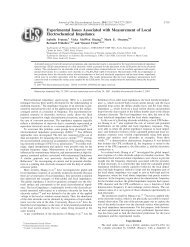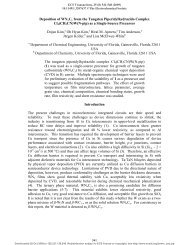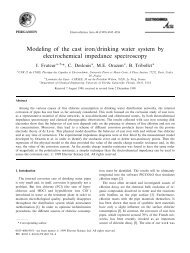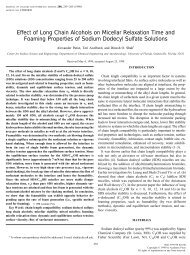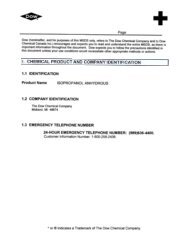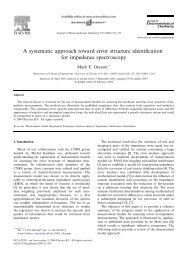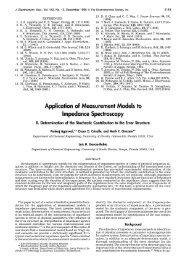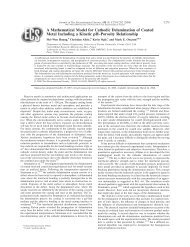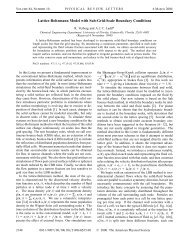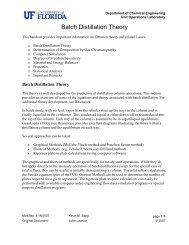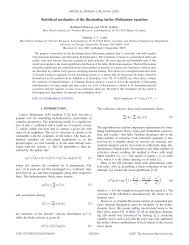On the Application of the Kramers-Kronig Relations to Evaluate the ...
On the Application of the Kramers-Kronig Relations to Evaluate the ...
On the Application of the Kramers-Kronig Relations to Evaluate the ...
- No tags were found...
Create successful ePaper yourself
Turn your PDF publications into a flip-book with our unique Google optimized e-Paper software.
J. Electrochem. Soc., Vol. 138, No. 1, January 1991 9 The Electrochemical Society, Inc. 6727. P. Furchhammer and H. J. Engell, Werkst. Korros., 20,1 (1969).28. Y. M. Kolotyrkin, This Journal, 108, 209 (1961).29. H. P. Leckie and H. H. Uhlig, ibid., 113, 1262 (1966);116, 906 (1969).30. J. O'M. Bockris, D. Dra~id, and A. Despid, Electrochim.Acta, 4, 325 (1961).31. S. Asakura and K. Nobe, This Journal, 118, 13, 19(1971).32. C. L. McBee and J. Kruger, in "Localized Corrosion,"R.W. Staehle, B. F. Brown, and J. Kruger, Edi<strong>to</strong>rs,p. 252, NACE, Hous<strong>to</strong>n, TX (1974).33. T. P. Hoar and W. R. Jacob, Nature, 216, 1299 (1967).34. T. P. Hoar, Corros. Sci., 7, 355 (1967).35. N. Sa<strong>to</strong>, Electrochim. Acta, 16, 1683 (1971).36. N. Sa<strong>to</strong>, This Journal, 129, 255 (1982).37. G. Okamo<strong>to</strong> and T. Shibata, Corros. Sci., 10, 371 (1970).38. W. E. O'Grady and J. O'M. Bockris, Surf. Sci., 10, 249(1973).39. G. Okamo<strong>to</strong>, Corros. Sci., 13, 471 (1973).40. W. E. O'Grady, This Journal, 127, 555 (1980).41. J. Kruger, in "Passivity and Its Breakdown on Ironand Iron-Based Alloys," R. W. Staehle and H. Okada,Edi<strong>to</strong>rs, p. 91, NACE, Hous<strong>to</strong>n, TX (1976).42. M. A. Heine, D. S. Keir, and M. S. Pryor, This Journal,112, 29 (1965).43. M. J. Pryor, in "Localized Corrosion," R.W. Staehle,B.F. Brown, and J. Kruger, Edi<strong>to</strong>rs, p. 2, NACE,Hous<strong>to</strong>n, TX (1974).44. C. Y. Chao, L. F. Lin, and D. D. Macdonald, This Journal,128, 1187, 1194 (1981).45. J. A. Richardson and G. C. Wood, Corros. Sci., 10, 313(1970); This Journal, 120, 193 (1973).46. K. Hashimo<strong>to</strong> and K. Asami, Corros. Sci., 19, 251 (1979).47. R. Nishimura, M. Araki, and K. Kudo, Corrosion, 40,465 (1984).48. B. MacDougall, D. F. Mitchell, G. I. Sproule, and M. J.Graham, This Journal, 130, 543 (1983).49. M. Urquidi-Macdonald and D. D. Macdonald, ibid.,134, 41 (1987).<strong>On</strong> <strong>the</strong> <strong>Application</strong> <strong>of</strong> <strong>the</strong> <strong>Kramers</strong>-<strong>Kronig</strong> <strong>Relations</strong> <strong>to</strong> <strong>Evaluate</strong><strong>the</strong> Consistency <strong>of</strong> Electrochemical Impedance DataJ. Mat<strong>the</strong>w Esteban* and Mark E. Orazem*Department <strong>of</strong> Chemical Engineering, University <strong>of</strong> Florida, Gainesville, Florida 326I tABSTRACTThe use <strong>of</strong> <strong>the</strong> <strong>Kramers</strong>-<strong>Kronig</strong> (KK) relations <strong>to</strong> evaluate <strong>the</strong> consistency <strong>of</strong> impedance data has been limited by <strong>the</strong>fact that <strong>the</strong> experimental frequency domain is necessarily finite. Current algorithms do not distinguish between <strong>the</strong> residualerrors caused by a frequency domain that is <strong>to</strong>o narrow and discrepancies caused by a system which does not satisfy<strong>the</strong> constraints <strong>of</strong> <strong>the</strong> KK equations. A new technique is presented which circumvents <strong>the</strong> limitation <strong>of</strong> applying <strong>the</strong>KK relations <strong>to</strong> impedance data which truncate in <strong>the</strong> capacitive region. The proposed algorithm calculates impedancevalues below <strong>the</strong> lowest experimental frequency which "force" <strong>the</strong> data set <strong>to</strong> satisfy <strong>the</strong> KK equations. Internally consistentdata sets yield low-frequency impedance values which are continuous at <strong>the</strong> lowest measured experimental frequency.A discontinuity between <strong>the</strong> calculated low-frequency values and <strong>the</strong> experimental data indicates inconsistencywhich cannot be attributed <strong>to</strong> <strong>the</strong> finite experimental frequency domain.To facilitate <strong>the</strong> interpretation <strong>of</strong> impedance measurements,an investiga<strong>to</strong>r should know whe<strong>the</strong>r <strong>the</strong> experimentaldata is characteristic <strong>of</strong> a linear and stable system.It has been suggested that <strong>the</strong> <strong>Kramers</strong>-<strong>Kronig</strong> (KK) relationscan be employed <strong>to</strong> evaluate and analyze compleximpedance data <strong>of</strong> electrochemical systems (1-3). Theseequations, developed for <strong>the</strong> field <strong>of</strong> optics, constrain <strong>the</strong>real and imaginary components <strong>of</strong> complex physical quantitiesfor systems that satisfy <strong>the</strong> conditions <strong>of</strong> causality,linearity, stability, and finite impedance values at <strong>the</strong> frequencylimits <strong>of</strong> zero and infinity (4-6). Bode (7) extended<strong>the</strong> concept <strong>to</strong> electrical impedance, and has tabulated variousforms <strong>of</strong> <strong>the</strong>se equations. Macdonald and Urquidi-Macdonald (8) have demonstrated analytically that equivalentelectrical circuits involving passive elements (R, C, L),<strong>the</strong> Warburg impedance, <strong>the</strong> pore diffusion model, R--Ctransmission lines, R--L transmission lines, and R--C--Ltransmission lines obey <strong>the</strong> KK relations. Consequently,experimental data that can be fitted <strong>to</strong> <strong>the</strong> analytical response<strong>of</strong> an equivalent circuit described above throughnonlinear regression analysis satisfy <strong>the</strong> conditions <strong>of</strong> <strong>the</strong>KK relations.There is, however, controversy over <strong>the</strong> extent <strong>to</strong> which<strong>the</strong> KK relations can be used <strong>to</strong> validate electrochemicalimpedance data. The relationships are held <strong>to</strong> be valid, butMansfeld and Shih (9-11) have argued that <strong>the</strong>y are uselessfor data that do not include all <strong>the</strong> time constants for <strong>the</strong>system. Since <strong>the</strong> KK relations involved integrals over frequenciesranging from zero <strong>to</strong> infinity, valid data can appear<strong>to</strong> be invalid if <strong>the</strong> measured frequency range is insufficient.Macdonald et al. (2, 3, 12) have repeatedlyemphasized <strong>the</strong> importance <strong>of</strong> collecting experimental* Electrochemical Society Active Member.data over a sufficiently wide frequency range in order <strong>to</strong>evaluate <strong>the</strong> KK relations with satisfac<strong>to</strong>ry accuracy, butthis is not always possible. While <strong>the</strong> upper limit <strong>of</strong> modernfrequency analyzers (65 kHz <strong>to</strong> 1 MHz) is sufficient formost electrochemical systems, <strong>the</strong> lower measureable frequencylimit for systems exhibiting large time constants is<strong>of</strong>ten governed by noise. It is this value that currently restricts<strong>the</strong> utility <strong>of</strong> <strong>the</strong> KK transforms.There is, <strong>the</strong>refore, a need <strong>to</strong> address <strong>the</strong> problem <strong>of</strong> applying<strong>the</strong> KK relations <strong>to</strong> data sets with finite frequencydomains which do not extend <strong>to</strong> a sufficiently low value.<strong>On</strong>ce this problem is properly resolved <strong>the</strong>n <strong>the</strong> sensitivity<strong>of</strong> <strong>the</strong> KK relations <strong>to</strong> evaluate experimental impedancedata for violations <strong>of</strong> <strong>the</strong> causality, linearity, and stabilityconditions can be individually investigate d . Previous authorshave approached <strong>the</strong> problem differently:Mansfeld and Shih (9-11) stated that <strong>the</strong> KK transformsyield valid results only when <strong>the</strong> impedance data havereached a dc limit within <strong>the</strong> experimental frequency domain.<strong>Application</strong> <strong>of</strong> a KK algorithm <strong>to</strong> valid data setswhich truncate in <strong>the</strong> capacitive region result in discrepanciesthat may erroneously lead <strong>to</strong> <strong>the</strong> conclusion that <strong>the</strong>data sets are invalid. These discrepancies, however, aredue <strong>to</strong> <strong>the</strong> neglected contributions <strong>to</strong> <strong>the</strong> integrals associatedwith <strong>the</strong> inaccessible frequency domain (12). In onespecific case, <strong>the</strong>y were able <strong>to</strong> validate <strong>the</strong> experimentaldata using a KK algorithm only after having extrapolated<strong>the</strong> data below <strong>the</strong> lowest measured frequency using <strong>the</strong>fitting parameters <strong>of</strong> an equivalent circuit (10). This shows<strong>the</strong> importance <strong>of</strong> performing <strong>the</strong> integration over <strong>the</strong>widest frequency domain possible. It should be pointedout that, since <strong>the</strong> impedance response <strong>of</strong> electrical circuitssatisfy <strong>the</strong> KK relations, a "good fit" between <strong>the</strong> experimentaldata and <strong>the</strong> analytic response <strong>of</strong> an equivalent
68 J. Electrochem. Soc., Vol. 138, No. 1, January 1991 9 The Electrochemical Society, Inc.circuit (i.e., which exhibit randomly distributed residuals)indicates that <strong>the</strong> data set satisfies <strong>the</strong> constraints associatedwith <strong>the</strong> KK relations (8, 13).Macdonald et al. (3) suggested extrapolating <strong>the</strong> experimentaldata beyond <strong>the</strong> frequency extremes using polynomialexpressions obtained from a regression analysis <strong>of</strong><strong>the</strong> data set. Although this procedure minimizes <strong>the</strong> problem<strong>of</strong> <strong>the</strong> "<strong>the</strong> inaccessible 'tails' <strong>of</strong> <strong>the</strong> integrals" (12), extrapolation<strong>of</strong> higher order polynomials in this manner isdangerous and may be justifiable only within a narrow frequencydomain.It is evident from <strong>the</strong> discussions <strong>of</strong> Shih and Mansfeldand Macdonald and Urquidi-Macdonald that <strong>the</strong> application<strong>of</strong> <strong>the</strong> KK relations <strong>to</strong> a broad range <strong>of</strong> experimentalimpedance data requires a method <strong>to</strong> eliminate errors associatedwith <strong>the</strong> unmeasured frequency domain. The object<strong>of</strong> this work was <strong>to</strong> develop such an algorithm that candistinguish between errors due <strong>to</strong> a finite frequency domainthat is <strong>to</strong>o narrow and discrepancies due <strong>to</strong> data thatare truly inconsistent with <strong>the</strong> KK relations. This algorithmis intended <strong>to</strong> reduce <strong>the</strong> possibility for false rejection<strong>of</strong> a valid data set caused by an insufficient experimentalfrequency domain. The utility <strong>of</strong> <strong>the</strong> proposedtechnique is illustrated using syn<strong>the</strong>tic data derived fromequivalent circuits. Since <strong>the</strong> conditions <strong>of</strong> <strong>the</strong> KK relationsare necessarily satisfied, <strong>the</strong> sensitivity <strong>of</strong> <strong>the</strong> techniquefor checking <strong>the</strong> violation <strong>of</strong> <strong>the</strong> stability criterionwas investigated. The authors are currently investigating<strong>the</strong> application <strong>of</strong> this procedure <strong>to</strong> time-dependent processessuch as <strong>the</strong> corrosion <strong>of</strong> copper, aluminum alloys,and hydrogenation <strong>of</strong> metal hydrides, and <strong>the</strong> extension <strong>of</strong><strong>the</strong> method for application <strong>to</strong> purely capacitive systems.These will be addressed in subsequent papers.ConceptThrough <strong>the</strong> KK relations, <strong>the</strong> value <strong>of</strong> one impedancecomponent (real or imaginary) can be calculated at anygiven frequency if <strong>the</strong> o<strong>the</strong>r component is known over <strong>the</strong>entire frequency range. However, experimental difficultiesconstrain <strong>the</strong> acquisition <strong>of</strong> data within a finite frequencydomain ~i, -< <strong>to</strong> < <strong>to</strong> .... The apparent lack <strong>of</strong> agreementbetween <strong>the</strong> experimental data and <strong>the</strong> corresponding KKtransformations can be attributed <strong>to</strong> two fac<strong>to</strong>rs: (i) <strong>the</strong>problem <strong>of</strong> residuals due <strong>to</strong> <strong>the</strong> unmeasured impedancevalues in <strong>the</strong> frequency ranges o~ < ~,.m and ~o > <strong>to</strong>~, and,(ii) <strong>to</strong> processes associated with a nonstationary, nonlinear,and/or noncausat system.The contributions <strong>to</strong> <strong>the</strong> integrals <strong>of</strong> <strong>the</strong> KK relationspredominantly arise in <strong>the</strong> region near <strong>the</strong> frequencybeing evaluated (1). This means that if an experimentaldata Set truncates in <strong>the</strong> capacitive region <strong>the</strong> problem <strong>of</strong>residuals described by fac<strong>to</strong>r (i) will be much more significantat <strong>the</strong> low-frequency range than at <strong>the</strong> high-frequencyrange. This is evident from <strong>the</strong> examples given inRef. (9-11) where <strong>the</strong> greatest discrepancies between <strong>the</strong>experimental data and <strong>the</strong> calculated impedance valuesoccurred at low frequencies.The concept behind this work is that functions Z~(<strong>to</strong>) andZ~(~o) can be found for <strong>the</strong> low-frequency domaincoo
L70 J. Electrochem. Soc., Vol. 138, No. 1, January 1991 9 The Electrochemical Society, Inc.~.0 l,liilll I I'lNlli~ ,liillit-illlill I ,illilll I ,,lilii I lilili, I ililiil I lllilill-Hl'll6,0 -- b a~.oSO07.0- C - ~ I: Theor'etlcal -- l.S_ b: Itilin- l HI6.0 -- C: ~.1, " i0 Ha -- t.25.00.804.08500II1\1 ~ O.,n-O,.,iiit ~ ~176400 / J / ~ d : Umj n - 5.0 Hi3,0 0.4i'~ 200t,0o.o u,r I =Hind ~H~lal IHI,~ ~u,~ ~IHI~ Im~ ~und ~mld ~ml -~.4i0 -~ ~0 -~0 -~ t0 ~ ~0 ~ ~0 ~ ~0 ~ ~104 t0 ~ tO s t07Frequency.Fig. 5. Calculated low-frequency impedance values for <strong>the</strong> Rondles/CPE electrical circuit <strong>of</strong> Fig. 2c. This figure illustrates <strong>the</strong> effect <strong>of</strong> increasingtruncation frequency, while maintaining <strong>the</strong> value <strong>of</strong> r o at10 -z Hz. a, Theoretical impedance response; b, calculated impedancevalues in <strong>the</strong> frequency range 10 -~ <strong>to</strong> 1 Hz; c, calculated impedancevalues in <strong>the</strong> frequency range 10 -3 <strong>to</strong> 10 Hz; d, calculated impedancevalues in <strong>the</strong> frequency range 10 -~ <strong>to</strong> 50 Hz.an indication <strong>of</strong> <strong>the</strong> internal consistency <strong>of</strong> <strong>the</strong> data set.The polynomial expressions defined in Eq. [A-3] and [A-4],Appendix A, effectively smoo<strong>the</strong>d <strong>the</strong> scattered impedancedata contained in good-noise. The results for badnoiseshow <strong>the</strong> calculated impedance below <strong>the</strong> truncationfrequency <strong>to</strong> be discontinuous with <strong>the</strong> experimental dataat r and suggest that bad-noise does not satisfy <strong>the</strong> KKrelations. The conclusions about <strong>the</strong> validity <strong>of</strong> <strong>the</strong>se noisydata sets obtained from <strong>the</strong> KK algorithm are consistentwith <strong>the</strong> residual-plot analyses derived from LOMFP.Invalid data sets.---The examples presented in this sectionare for nonstationary systems. Syn<strong>the</strong>tic data weregenerated for <strong>the</strong> equivalent circuit shown in Fig. 2d bymaking <strong>the</strong> value <strong>of</strong> <strong>the</strong> resis<strong>to</strong>r R, or <strong>the</strong> capaci<strong>to</strong>r C, varywith time (see <strong>the</strong> section on simulation <strong>of</strong> inconsistent independencedata in Appendix B). The "experimental" frequencyrange was 0.1 Hz-65 kHz. Ten data points were collectedper logarithmic decade <strong>of</strong> frequency and <strong>the</strong>number <strong>of</strong> delay cycles at each frequency N was six. In-2.5Hz_Ira,, I J lHIII~ IHm, I I BHHI~ J lltll~ J lHI]~ I IHHI~;>.O El, b 8: Theoretical ~mpedanc~_C " ~ b: vei n - 0.5 HZ -,.~ d _ \ o: =.,o . ,.o., -%"~ ~K~ r v.,. SOHzO3Ec" l.O0E o.ep.,io.o _--- i-o.5-I IIl,~ J lHII~ I lllll "l I IIlil~ I lilll ''l I IIIlll~ I nilll~ i ltl,~ III]0 -4 ]0 -~ ]0 -a ]0 -~ ~0 ~ ]0 J ]0 a ]0 ~ 10 ~ t0 sFrequency.Fig. 6. Calculated low-frequency real impedance values for <strong>the</strong> electricalcircuit <strong>of</strong> Fig. 2d. This figure illustrates <strong>the</strong> effect <strong>of</strong> increasingtruncation frequency, while moin<strong>to</strong>inlng <strong>the</strong> value <strong>of</strong> o~o at 10 -4 Hz. a,Theoretical impedance response; b, calculated real impedance valuesin <strong>the</strong> frequency range ~0 -~ <strong>to</strong> O.i Hz; C, coiculated real impedancevalues in <strong>the</strong> frequency range 10 -4 <strong>to</strong> 1 Hz; d, calculated real impedancevolues in <strong>the</strong> frequency range 10 -4 <strong>to</strong> 5 Hz.Hzo7-zoo ~n~ ~md ,m~,~ ~n~ ~H~ ~lm~ ~n~ ~HH~I ~H~I0 -4 ~0 -s I0 -~ I0 -i I0 ~ lO ~ I0 z ~0 ~ jO 4 IO sFrequency,Fig. 7. Calculated low-frequency imaginary impedance values for <strong>the</strong>electrical circuit <strong>of</strong> Fig. 2d. This figure illustrates <strong>the</strong> effect <strong>of</strong> increasingtruncation frequency, while maintaining <strong>the</strong> value <strong>of</strong>
= -72 J. Electrochem. Soc., Vol. 138, No. 1, January1991 9 The Electrochemical Society, Inc.Table I, Fitted parameters for <strong>the</strong> equivalent circuit <strong>of</strong> Fig, 2d with a variable resis<strong>to</strong>r R~ usingf = 0.0. The nons<strong>to</strong>tionary systems with various degrees <strong>of</strong> inconsistency ore givenFP (10). The consistent data set is given forby f = 0.1, 0.175, 0.25, and 0.5f R~, I~ R~, ~ C1, F R~, 12 C~, F Rw, 12 Tw,~0.0 23.22 418.3 1.88E-5 695.2 9.26E-5 846.4 0.70550.100 23.22 419.1 1.87E-5 699.0 9.24E-5 857.3 0.71410.175 23.41 420.2 1.87E-5 701.7 9.22E-5 865.8 0.72040.250 23.48 421.0 1.86E-5 704.3 9.20E-5 874.3 0.72650.500 23.74 423.3 1.84E-5 712.3 9.15E-5 903.73 0.7459two orders <strong>of</strong> magnitude greater than <strong>the</strong> o<strong>the</strong>r time constants.Acceptable bounds for levels <strong>of</strong> discontinuity at <strong>the</strong>truncation frequency were obtained by comparison <strong>to</strong>changes in <strong>the</strong> calculated values <strong>of</strong> <strong>the</strong> circuit parameters.The results are presented in Fig. 16, which illustrates <strong>the</strong>percent difference between <strong>the</strong> values <strong>of</strong> <strong>the</strong> circuit elementsfor <strong>the</strong> stationary and nonstationary systems as afunction <strong>of</strong> <strong>the</strong> percent difference between <strong>the</strong> calculatedand <strong>the</strong> experimental values for <strong>the</strong> real impedance at o~,.For <strong>the</strong>se nonstationary systems, a discontinuity <strong>of</strong> lessthan 15% represents a deviation <strong>of</strong> less than -+5% for <strong>the</strong>Circuit elements not associated with <strong>the</strong> dominant timeconstant. In o<strong>the</strong>r words, regression <strong>of</strong> data showing a 15%discontinuity can be expected <strong>to</strong> yield circuit parametersassociated with electrochemical reaction rate constantswithin 5% <strong>of</strong> <strong>the</strong> values that would apply at <strong>the</strong> beginning<strong>of</strong> <strong>the</strong> experiment. The Warburg component would show alarge error. This establishes an error bounds for <strong>the</strong> circuitparameters <strong>of</strong> impedance data sets deemed <strong>to</strong> be inconsistent.The effect <strong>of</strong> truncating high-frequency impedance data.-The algorithm incorporated an assumption that <strong>the</strong> highfrequencyimpedance data have negligible contributions<strong>to</strong> <strong>the</strong> integral when <strong>the</strong> KK equations are evaluated at lowfrequencies. There is a limit <strong>to</strong> <strong>the</strong> truncation <strong>of</strong> high-frequencydata, however, for this assumption <strong>to</strong> be valid.Low-frequency impedance values were calculated for<strong>the</strong> equivalent circuit shown in Fig. 2d with decreasing(0max. The results are presented inFig. 17. The Bode plotsfor ~om~ = 10 kHz show that <strong>the</strong> calculated low-frequencyimpedance is continuous with <strong>the</strong> available data at 0.1 Hz.However, when O~max = 1 kHz, <strong>the</strong>re is a distinct discontinuityat r due <strong>to</strong> <strong>the</strong> residual errors at <strong>the</strong> high-frequencyextreme.The maximum frequency r must be sufficiently largethat <strong>the</strong> impedance data at <strong>the</strong> high-frequency range donot truncate in <strong>the</strong> capacitive region. This requirement canbe relaxed by assuming polynomial expressions for <strong>the</strong>real and imaginary impedance in <strong>the</strong> range <strong>to</strong> > coax. Additionalsummation terms and polynomial coefficientswould be introduced in<strong>to</strong> Eq. [12] and [13] <strong>to</strong> account for<strong>the</strong> new intervals at <strong>the</strong> high-frequency extreme.Numerical constraints.--The accuracy <strong>of</strong> <strong>the</strong> calculationsis influenced by <strong>the</strong> choice <strong>of</strong> <strong>the</strong> adjustable parameters<strong>of</strong> <strong>the</strong> algorithm (see Appendix A). The polynomial ordersK and M must be sufficient <strong>to</strong> establish <strong>the</strong> behavior<strong>of</strong> <strong>the</strong> impedance components within <strong>the</strong> low-frequencyrange; values for K and M between 6 and 10 were deemed<strong>to</strong> be adequate. As illustrated in Fig. 4, <strong>the</strong> problem <strong>of</strong> residualswas minimized by setting coo <strong>to</strong> be about three orfour orders <strong>of</strong> magnitude less than COmic. The parameters N~and N~ were specified by dividing <strong>the</strong> entire frequencyrange in<strong>to</strong> logarithmic decades, and assigning 300 <strong>to</strong> 1000~i divisions per decade. There was minimal difference between<strong>the</strong> results obtained when ~i : 1000 and when~ = 300 (note that <strong>the</strong> optimal value for 8~ can be determinedif an adaptive quadrature method were employed).A noticeable difference was observed when double precision(8-byte floating-point number) was employed as compared<strong>to</strong> extended precision (10-byte floating-point number);<strong>the</strong> discrepancy is due <strong>to</strong> round-<strong>of</strong>f errors when <strong>the</strong>summations are performed.When Nc = 4, N~ = 6, ~i = 1000, and K = M = 9, <strong>the</strong>re are10,000 evenly spaced frequency divisions, and <strong>the</strong> summationroutine is performed at 20 frequencies within~o0 --- <strong>to</strong> < O~m~ .. The average computational time required forimplementing <strong>the</strong> algorithm under <strong>the</strong>se conditions wasapproximately 5 min on a 16 MHz 80386 personal computerwith a math co-processor.ConclusionAn approach has been presented which successfully resolves<strong>the</strong> problem <strong>of</strong> applying <strong>the</strong> KK relations <strong>to</strong> impedancedata which do not exhibit a dc limit. This method differsfrom current KK algorithms such that it does notrequire extrapolation <strong>of</strong> <strong>the</strong> experimental data beyond <strong>the</strong>measurable frequency domain in order <strong>to</strong> evaluate <strong>the</strong> in-300025002000:-~ ~ll.,~ 1.1,~ I J,,,~ i~.l,q I IH,, I ~,,,~ IH,,~ IH_--- ~ a: f - -0. I~,- a " ~ b: f "-0.1751600 30001400 2500t200 2000~ ~ ~ ~ F T ~ ,s00- --- 14o<strong>of</strong> - <strong>to</strong>-Sb: f - 5xi0-s ..-~_- ,200t500~ t000500d: f - -0.51000 t500.00 g g ,ooooo0~ ~ 6OO .0_zo,.,400 0400-500-lO00-t500~ . -zl i,.,) o:llIlll~ [Itllill~ IIIIII,] llilfilll flfllll~ IIIIII~ lllfll~ lIIll(d lllf -2oo10 -4 1.0 -s :10-2 10 -t iO 0 ~0 t :10 a 10 3 10 4 :105Frequency.Fig. 13. Calculated low-frequency impedance values for a simulatednonstationary system in <strong>the</strong> frequency range 10 -4 <strong>to</strong> 0.1 Hz. The electricalcircuit <strong>of</strong> Fig. 2d was used with a variable resis<strong>to</strong>r R~ and negativevalues <strong>of</strong> "inconsistency fac<strong>to</strong>r" f. The value <strong>of</strong> <strong>the</strong> resis<strong>to</strong>r decreasedduring <strong>the</strong> course <strong>of</strong> <strong>the</strong> "experiment." Curve a: f=-0.1(AR1 =--7.0%), b: f=-0.175 (AR~ =-12.2%), c: f=-0.25(ARI = - 17.4%), d: f = -0.5 (~R1 = -35.0%).Hz200 -500-t000-1500:lL.,~ i i.,d ,..ll i.,Id ~Hml i.,id J.l,d I.,~ i.t~ -~ooI0 -4 I0 -3 i0 .2 I0 -I I0 ~ IO ~ :10 2 10 3 I0 4 IO SFrequency,Fig. 14. Calculated low-frequency impedance values for a simulatednonstationary system in <strong>the</strong> frequency range 10 -4 <strong>to</strong> 0,| Hz. The electricalcircuit <strong>of</strong> Fig. 2d was used with a variable capaci<strong>to</strong>r CI and positivevalues <strong>of</strong> "inconsistency fac<strong>to</strong>r" f. The value <strong>of</strong> <strong>the</strong> capaci<strong>to</strong>r increasedduring <strong>the</strong> course <strong>of</strong> <strong>the</strong> "experiment." Curve a: f = 10 -s(ACI= 15.5%), b: f=5• 10 -s (AC1=77.5%), c: f= 10 -7(ACI = 155%).Hz200o
J. Electrochem. Soc., Vol. 138, No. 1, January 1991 9 The Electrochemical Society, Inc. 73,ooo \ , ,._o,o,80060040O2500 ~1 lillll~ t lllllll t I III111~ I IIIIIll I I llllJl~ I lliJllJ] I IH(J~I~-[~_ eoo2000 ~-.~. a /'~ a: =...- <strong>to</strong> k,z -.... .'.'.'.'.' :::::: soo-- b b: ula I = | kHzA500~ooo ~ c k500ozr (w)-200-400~N.;~~- 2oo N5000I-soo -~ u)H)~ ~ u).l,l I.II)~ )))ud ))I))l~ I I)))Ig I I)~),~ luI.~ )I)I~ -~oo~0 -( 1.0 -3 10 -2 ~0 -~ ~.0 ~ iO ~ ~0 ~ I0 ~ i0 ( I0 sFrequency, HzFig. | 5. Calculated low-frequency impedance values for a simulatednonstationary system in <strong>the</strong> frequency range 10 4 <strong>to</strong> 0.1 Hz. The electricalcircuit <strong>of</strong> Fig. 2d was used with a variable capaci<strong>to</strong>r C~ and negativevalues <strong>of</strong> "inconsistency fac<strong>to</strong>r" f. The value <strong>of</strong> <strong>the</strong> capaci<strong>to</strong>r decreasedduring <strong>the</strong> course <strong>of</strong> <strong>the</strong> "experiment." Curve a: f = -10 -e(AC1 = -15.5%), b: f = -5 x 10 -~ (ACI = -77.5%), c: f = -10 -7(AC) = - 155%).-~ooHllliJ ~ulll)l l llllll~ l lu,,I l lll,l~ luIlIl~ luI,d l ltll~ -2oo~0 -4 ~,0 -3 ~,0 -2 iO -1 iO ~ ~01 iO 2 10 3 iO 4F'requency, HzFig. 17. The effect <strong>of</strong> decreasing O)ma x on <strong>the</strong> algorithm attributable<strong>to</strong> <strong>the</strong> problem <strong>of</strong> residuals at <strong>the</strong> high-frequency extreme. The datasets were from <strong>the</strong> equivalent circuit <strong>of</strong> Fig. 2d and co,~, = 0.1 Hz.Curve a: C%ax = 10 kHz; and b: O)ma x = 1 kHz. a, Calculated impedancevalues in <strong>the</strong> frequency range 10 -4 <strong>to</strong> 0.1 Hz when~0=~ = 110 kHz; b, calculated impedance values in <strong>the</strong> frequencyrange 10 -4 <strong>to</strong> 0.1 Hz when (Oma x = 1 kHz.tegrals <strong>of</strong> <strong>the</strong> KK relations. The proposed technique usesonly <strong>the</strong> available impedance data, which is necessarilyconstrainted within a finite frequency domain. The onlyrequirement for testing <strong>the</strong> consistency <strong>of</strong> <strong>the</strong> data using<strong>the</strong> method presented in this paper is that <strong>the</strong> highestmeasured frequency should be large enough <strong>to</strong> ensure that<strong>the</strong> high-frequency impedance data do not terminate in<strong>the</strong> capacitive region.This KK algorithm should facilitate <strong>the</strong> analysis and interpretation<strong>of</strong> experimental data. This procedure complements<strong>the</strong> method <strong>of</strong> fitting impedance data <strong>to</strong> an equivalentcircuit; in part because a fitting procedure can be atedious and time consuming exercise. By first appl~-ing <strong>the</strong>KK algorithm, an experimenter will know whe<strong>the</strong>r <strong>the</strong>data are suitable for analysis by a fitting procedure. If <strong>the</strong>experimental data is found <strong>to</strong> satisfy <strong>the</strong> KK relations,<strong>the</strong>n an equivalent circuit could be found which will providea "good" and acceptable fit. O<strong>the</strong>rwise, <strong>the</strong> experimenterwill be aware <strong>of</strong> <strong>the</strong> inconsistency <strong>of</strong> <strong>the</strong> data set,and should interpret <strong>the</strong> results <strong>of</strong> <strong>the</strong> fitting procedure inlight <strong>of</strong> a possible violation <strong>of</strong> one <strong>of</strong> <strong>the</strong> conditions <strong>of</strong> <strong>the</strong>KK relations.AcknowledgmentsThis material is based upon work supported by <strong>the</strong> NationalScience Foundation under Grant no. EET-8617057and on work supported by DARPA under <strong>the</strong> Op<strong>to</strong>electronicsprogram <strong>of</strong> <strong>the</strong> Florida Initiative in Advanced Microelectronicsand Materials. The writers also wish <strong>to</strong> acknowledge<strong>the</strong> contributions <strong>of</strong> Conrad B. Diem.Manuscript submitted Jan. 15, 1990; revised manuscriptreceived Aug. 2, 1990.i01I i I I I I IlJ I I IoAPPENDIX AAlgorithm far Calculating Low-Frequency ImpedanceThe two forms <strong>of</strong> <strong>the</strong> KK relations (3, 7) employed in thisalgorithm wereZi(r = - 10 x---- ~-_ w~ dx [A-l]uCL2q--4~C0JUr0Jn10 ol0 -s~0 ~ 2 3II&B I/AAW= ~ Z~t SYNBOLS --o R w 9 T N0 FIt o C!,~ R 2 ~ C 2v R sI I I IIII I I I4 5 6 7 eg ~.01 2 3 4 5} Zr. expt - Zr. calc I /Zr. expt * :iO02 r| xZi(x) - coZi(~)z~(~o) : Z~(| + ~ ~o/ -~ --~ dx [A-2]Zr(r and Zi(r are <strong>the</strong> real and imaginary components <strong>of</strong><strong>the</strong> impedance, and r and x are angular frequencies. Equation[A-l] represents <strong>the</strong> imaginary impedance that is internallyconsistent with <strong>the</strong> real component <strong>of</strong> <strong>the</strong> experimentaldata. Equation [A-2] represents <strong>the</strong> real impedancethat is internally consistent with <strong>the</strong> imaginary component<strong>of</strong> <strong>the</strong> experimental data.Based on <strong>the</strong> assumptions presented in <strong>the</strong> section onConcept, <strong>the</strong> infinite integration region for <strong>the</strong> KK equationsis limited <strong>to</strong> r -< x -< r Experimental data wereassumed <strong>to</strong> be available for <strong>the</strong> frequency ranger --< X --< COmax; <strong>the</strong> real component reaches an asymp<strong>to</strong>teZr| and <strong>the</strong> imaginary component approaches zero at ~0max.The object <strong>of</strong> <strong>the</strong> algorithm was <strong>to</strong> determine <strong>the</strong> functionsfor <strong>the</strong> real and imaginary componentsFig. 16. The effect on inconsistency on <strong>the</strong> calculated parameters <strong>of</strong><strong>the</strong> equivalent circuit <strong>of</strong> Fig. 2d. The abscissa represents <strong>the</strong> percentdifference between <strong>the</strong> real component <strong>of</strong> <strong>the</strong> data set and <strong>the</strong> calculatedreal impedance at con. The ordinate is <strong>the</strong> percent different between<strong>the</strong> values <strong>of</strong> <strong>the</strong> circuit elements <strong>of</strong> <strong>the</strong> nonstationary and stationarysystems.KZr(oJ1) = ~ a(k l) (log ~o~) k [A-3]k=0MZi(00,) = • a~ )(log <strong>to</strong>,) m [A-4]m=O
74 J. Electrochem. Soc., Vol. 138, No. 1, January 1991 9 The Electrochemical Society, Inc.within <strong>the</strong> low-frequency range r
J. Electrochem. Soc., Vol. 138, No. 1, January 1991 9 The Electrochemical Society, Inc. 75match <strong>the</strong> set <strong>of</strong> polynomial coefficients for both equations where[for example, see algorithm 7.4, Ref. (16)].This iterative routine may be avoided by using Eq. [A-12]ftand [A-13] simultaneously when constructing <strong>the</strong> linearhsystem <strong>of</strong>(K + M + 2) equations. For example, Eq. [A-12] isZemployed when l is odd, and Eq. [A-13] when I is even. Thishdirect method yields polynomial coefficients that are validfor both equations and which result in residuals <strong>of</strong> compa-Prable orders <strong>of</strong> magnitude. This was <strong>the</strong> approach taken inK<strong>the</strong> calculations presented in this paper. The computerprogram <strong>to</strong> implement <strong>the</strong> algorithm was written in TurboPascal (Boriand International, Version 5.0) and compiled ~2in math mode. The gaussian elimination routine with ~1scaled-column pivoting (16) and <strong>the</strong> Simpson's rule routinewere performed using 80 bit "extended" floating-point 0-numbers <strong>to</strong> minimize round-<strong>of</strong>f errors.APPENDIX BTheoretical Impedance ExpressionsThe analytic expressions employed for calculating <strong>the</strong>impedance response <strong>of</strong> <strong>the</strong> equivalent circuits depicted inFig. 2 are listed in this section.Circuit 2a.--The real and imaginary impedance componentsfor <strong>the</strong> Randles circuit <strong>of</strong> Fig. 2a were calculatedfromZT(tO ) = Zr(~ ) + jZi(tO)= R~+ 2 s 2 -J" z 2 s1+ tO R1C 1 1 + (o R1C 1[B-l]Circuit 2b.--The impedance response for <strong>the</strong> Randlescircuit with a Warburg impedance shown in Fig. 2b is deconvolutedfrom <strong>the</strong> impedance response <strong>of</strong> <strong>the</strong> electricalcircuit <strong>of</strong> Fig. 2d by reducing <strong>the</strong> value <strong>of</strong> <strong>the</strong> time constantR2C2. Consequently, <strong>the</strong> impedance data are calculatedfrom Eq. [B-6] presented in <strong>the</strong> following section onCircuit 2d by setting <strong>the</strong> values <strong>of</strong> R2 and Cs equal <strong>to</strong> zero.Circuit 2c.--The electrical circuit <strong>of</strong> Fig. 2c was used <strong>to</strong>model <strong>the</strong> impedance behavior <strong>of</strong> mild steel in concentratedhydrochloric acid (17). It has a constant phase element(CPE), whose impedance is given by1ZCPE -- - - [B-2]Yo(JtOPThe rationale behind <strong>the</strong> use <strong>of</strong> this element is discussed inRef. (18), Since= pZ - ,ha= pA - ,z= coClp= K - ~C1@= Rw~l~ - d0eR2v2~= R1K + RwX~ + 6~R2= 6 ~= 1 + ~2~= 8 2 d- 0 -2= RsC2= ~/~ sin 6 - ~0- cos 4~= ~ cos ~0 + ~/0- sin 6= ~ sin O~ + ~/cos ~b= ~ cos 4~ - ~ sin= e* + e-*: e @ -- e-~2V~Y~Tw2Simulation <strong>of</strong> inconsistent impedance data.--Inconsistentimpedance data for a nonstationary system were simulatedby changing <strong>the</strong> value <strong>of</strong> a circuit element during<strong>the</strong> course <strong>of</strong> <strong>the</strong> "experiment." A simple case is <strong>to</strong> assumethat <strong>the</strong> value <strong>of</strong> <strong>the</strong> circuit element E varies proportionallywith time. ThereforeiEi = Eo + fN ~ ht~n-1[B-7]where Eo is <strong>the</strong> value <strong>of</strong> <strong>the</strong> circuit element at start <strong>of</strong> <strong>the</strong>experiment, i is <strong>the</strong> number <strong>of</strong> data points collected, and Eiis <strong>the</strong> value <strong>of</strong> E as <strong>the</strong> experiment progresses. The "inconsistencyfac<strong>to</strong>r" f accounts for <strong>the</strong> direction <strong>of</strong> change <strong>of</strong> E;<strong>the</strong> value <strong>of</strong> E decreases with time when f < 0, and increaseswhen f> 0. N represents <strong>the</strong> number <strong>of</strong> cyclesused <strong>to</strong> make measurement at a given frequency. The timerequired <strong>to</strong> complete one cycle is ht = 1/~0, and NAt = N/<strong>to</strong>corresponds <strong>to</strong> <strong>the</strong> <strong>to</strong>tal time which has elapsed when <strong>the</strong>measurement was performed. The expression for Ei becomeszEi = Eo + )~ E --1n-1 t<strong>On</strong>[B-8]where tO1 = 65 kHz since impedance experiments are usuallyperformed from 65 kHz down <strong>to</strong> low-frequency values.The percent difference between <strong>the</strong> initial value <strong>of</strong> <strong>the</strong> circuitelement and its value at any time during <strong>the</strong> "experiment"is given by<strong>the</strong> analytic expression for this equivalent circuit is( ctR1 ) ~R1Zw(a) = Zr(cO) + jZi(~) = R~ + a s + B -T - j az + B2 [B-4]where~ = l+YoRlt<strong>On</strong>cos(~)=YoRl<strong>to</strong>~sin(~)Circuit 2d.--The equivalent circuit <strong>of</strong> Fig. 2d was employed<strong>to</strong> model <strong>the</strong> impedance response <strong>of</strong> copper dissolutionin alkaline chloride solutions (19). The expressionemployed for <strong>the</strong> Warburg impedance Zw is given by (14)tanh (X/jtOTw)Zw = RwVj~Tw[B-5]The analytic impedance response <strong>of</strong> <strong>the</strong> equivalent circuitshown in Fig. 2d isZr(tO) = Z~(tO) + jZ~(~)= R~+ A2+N2 - j hs+Z~ [B-6]Ei - Eo fN ~ 1hEro - - - • 100 = ~ -- • 100 [B-9]EoEo ,,=1 t<strong>On</strong>Equation [B-8] was used <strong>to</strong> calculate <strong>the</strong> values <strong>of</strong> a variableresis<strong>to</strong>r or variable capaci<strong>to</strong>r, and was incorporatedin<strong>to</strong> <strong>the</strong> analytic expressions listed above <strong>to</strong> simulate anonstationary system. The value <strong>of</strong> N was set <strong>to</strong> 6 whengenerating <strong>the</strong> inconsistent data sets.REFERENCES1. R. L. Van Meirhaeghe, E. C. Du<strong>to</strong>it, F. Cardon, andW. P. Gomes, Electrochim. Acta, 29, 995 (1975).2. D. D. Macdonald and M. Urquidi-Macdonald, ThisJournal, 132, 2316 (1985).3. M. Urquidi-Macdonald, S. Real, and D. D. Macdonald,ibid., 133, 2018 (1986).4. R. de L. <strong>Kronig</strong>, J. Opt. Soc. Am. Rev. Sci. Instrum., 12,547 ((1926).5. H. A. Kramer, Phys., Zeits., 31), 522 (1929).6. B. Davies, "Integral Transforms and Their <strong>Application</strong>s,"Applied Ma<strong>the</strong>matical Series, Vol. 25, 2nded., Springer-Verlag, New York (1985).7. H. W. Bode, "Network Analysis and Feedback AmplifierDesign," D. Van Nostrand Co., Inc., New York(1945).8. D. D. Macdonald and M. Urquidi-Macdonald, ThisJournal,137, 515 (1990).9. H. Shih and F. Mansfeld, Corros. Sci., 28, 933 (1988).10. H. Shih and F. Mansfeld, in "Transient Techniques inCorrosion Science and Engineering," (PV89-1)W. H. Smyrl, D. D. Macdonald, and W. J. Lorenz, Ed-
76 J. Electrochem. Soc., Vol. 138, No. 1, January 1991 9 The Electrochemical Society, Inc.i<strong>to</strong>rs, p. 31, The Electrochemical Society S<strong>of</strong>tboundProceedings Series, Penning<strong>to</strong>n, NJ (1989).11. H. Shih and F. Mansfeld, Corrosion, 45, 325 (1989).12. D. D. Macdonald and M. Urquidi-Macdonatd, ibid., 45,327 (1989).13. M. C. H. McKubre, D. D. MacDonald, and J. R. Macdonald,in "Impedance Spectroscopy: EmphasizingSolid Materials and Systems," J. R. Macdonald, Edi<strong>to</strong>r,p. 180, John Wiley & Sons, Inc., New York(1987).14. J. R. Macdonald, "Complex Nonlinear Least SquaresImmittance Fitting Program: LOMFP," University<strong>of</strong> North Carolina, Chapel Hill, NC.15. K. Ohta and H. Ishida, AppL Spectros., 42, 952 (1988).16. R. L. Burden and J. D. Falres, "Numerical Analysis,"4th ed., Prindle, Weber & Schmidt, Bos<strong>to</strong>n, MA(1989).17. F. B. Growcock and R. J. Jasinski, This Journal, 136,2310 (1989).18. J. R. Macdonald, J. Anal. Chem., 223, 25 (1987).19. O. C. Moghissi, MS Thesis, University <strong>of</strong> Virginia,Charlottesville, VA (1989).The Effect <strong>of</strong> Tungsten on <strong>the</strong> Corrosion Behavior <strong>of</strong> AmorphousFe-Cr-W-P-C Alloys in 1M HCIHiroki Habazaki, Asohi Kawashima, Katsuhiko Asami, and Koji Hashimo<strong>to</strong>Institute for Materials Research, Tohoku University, Sendai 980, JapanABSTRACTThe active current density <strong>of</strong> Fe-8Cr-7W-13P-7C alloy is almost three orders <strong>of</strong> magnitude lower than that <strong>of</strong> <strong>the</strong>Fe-8Cr-13P-7C alloy. The passive current density in <strong>the</strong> low potential region also decreases with increasing alloy tungstencontent. The surface analysis by XPS reveals that chromium and tungsten ions are concentrated in <strong>the</strong> surface film on atungsten containing alloy in <strong>the</strong> active region. The thickness <strong>of</strong> <strong>the</strong> surface film formed on <strong>the</strong> low tungsten alloy in <strong>the</strong>active region is x-ray pho<strong>to</strong>electron spectroscopically infinite, whereas <strong>the</strong> film thickness on <strong>the</strong> Fe-SCr-7W-13P-7C alloyin <strong>the</strong> active region is <strong>of</strong> <strong>the</strong> same order <strong>of</strong> magnitude as <strong>the</strong> thickness <strong>of</strong> <strong>the</strong> passive film. The chromium enrichment in <strong>the</strong>passive film becomes more significant with increasing tungsten content. Passivation <strong>of</strong> low tungsten alloys seems <strong>to</strong> occurby <strong>the</strong> formation <strong>of</strong> <strong>the</strong> passive film with <strong>the</strong> least enrichment <strong>of</strong> chromium ions necessary for passivation due <strong>to</strong> differentdissolution rates <strong>of</strong> iron and chromium during a large amount <strong>of</strong> alloy dissolution. Passivation <strong>of</strong> tungsten containing alloystakes place through transformation <strong>of</strong> <strong>the</strong> air-formed film <strong>to</strong> <strong>the</strong> passive film as a result <strong>of</strong> preferential dissolution <strong>of</strong> asmall amount <strong>of</strong> iron without dissolution <strong>of</strong> chromium ions.It is well known that amorphous metal-metalloid alloyswith a certain amount <strong>of</strong> chromium have extremely highcorrosion resistance in neutral and acidic solutions (1-8).Such a high corrosion resistance <strong>of</strong> amorphous alloys hasbeen thought <strong>to</strong> be due <strong>to</strong> <strong>the</strong>ir chemical homogeneity andhigh passivating ability <strong>of</strong> amorphous alloys (3): amorphousalloys are free <strong>of</strong> defects such as grain boundariesand dislocations, and <strong>of</strong> compositional fractuation formedby solid-state diffusion, Such a chemical homogeneity assists<strong>the</strong> formation <strong>of</strong> a uniform passive film on amorphousalloys. The high chemical reactivity <strong>of</strong> amorphous alloys ispartly based on <strong>the</strong> existence <strong>of</strong> many coordinatively unsaturateda<strong>to</strong>ms which enhances dissolution <strong>of</strong> elementsunnecessary for <strong>the</strong> formation <strong>of</strong> <strong>the</strong> passive film. Rapiddissolution <strong>of</strong> such elements is responsible for <strong>the</strong> highpassivating ability due <strong>to</strong> rapid surface concentration <strong>of</strong>ions, such as chromic ions, necessary for passive film formation.The addition <strong>of</strong> molybdenum <strong>to</strong> amorphous iron-chromium-metalloidalloys fur<strong>the</strong>r improves <strong>the</strong> corrosionresistance (4-8). When sufficient amounts <strong>of</strong> chromium andmolybdenum are added, <strong>the</strong> amorphous iron-metalloid alloyspassivate spontaneously even in hot concentrated hydrochloricacid (5-8). It is also well known that <strong>the</strong> addition<strong>of</strong> molybdenum <strong>to</strong> stainless steels increases <strong>the</strong> corrosionresistance, especially resistance <strong>to</strong> occluded cell corrosion(9-11).Some <strong>of</strong> <strong>the</strong> present authors have carried out <strong>the</strong> analysis<strong>of</strong> surface films on amorphous and crystalline iron-basealloys containing chromium and molybdenum by x-raypho<strong>to</strong>electron spectroscopy and attempted <strong>to</strong> clarify <strong>the</strong>role <strong>of</strong> molybdenum in increasing <strong>the</strong> corrosion resistance(7, 8, 12). It has been revealed from <strong>the</strong>se investigationsthat in <strong>the</strong> active region, molybdenum ions are remarkablyenriched in a surface film but not in <strong>the</strong> passive film andthat <strong>the</strong> passive film is composed mostly <strong>of</strong> hydrated chromiumoxyhydroxide. They proposed a possible role <strong>of</strong> molybdenumin assisting <strong>the</strong> formation <strong>of</strong> <strong>the</strong> passive hydratedchromium oxyhydroxide film by considering <strong>the</strong>analytical data as well as passivation kinetics.The beneficial effect <strong>of</strong> tungsten has been known formany years. For example, tungsten improves resistance <strong>to</strong>pitting corrosion <strong>of</strong> stainless steels in chloride media(14, 15). Like molybdenum, <strong>the</strong> addition <strong>of</strong> tungsten improves<strong>the</strong> corrosion resistance <strong>of</strong> amorphous Fe-P-C alloyswith and without chromium in hydrochloric acid(4, 13). However, its effect in improving <strong>the</strong> corrosionresistance is not sufficiently unders<strong>to</strong>od yet.This work has been performed <strong>to</strong> clarify <strong>the</strong> beneficialrole <strong>of</strong> tungsten on <strong>the</strong> corrosion behavior <strong>of</strong> amorphousFe-Cr-W-P-C alloys in hydrochloric acid by combination <strong>of</strong>electrochemical methods and x-ray pho<strong>to</strong>electron spectroscopy.ExperimentalFe-xCr-yW-13 a<strong>to</strong>m percent (a/o) P-7 a/o C (x = 4, 6, and8 a/o; y = 0, 1, 2, 3, 5 and 7 a/o) alloy ingots were preparedby high-frequency induction melting <strong>of</strong> labora<strong>to</strong>ry madeiron phosphide and commercial iron carbide, tungsten,chromium, and iron under an argon atmosphere. Ironphosphide was prepared by sintering red phosphorus iniron. From <strong>the</strong>se ingots, amorphous alloy ribbons <strong>of</strong> about1 mm width and 10-30 ~m thickness were prepared by asingle-roller method. X-ray diffraction patterns <strong>of</strong> <strong>the</strong> alloyswere measured with <strong>the</strong> x-ray diffrac<strong>to</strong>meter using CuKs radiation. All <strong>of</strong> <strong>the</strong> specimens used showed only halopatterns characteristic <strong>of</strong> amorphous structure.Prior <strong>to</strong> electrochemical measurements, <strong>the</strong> amorphousalloy ribbons were polished in cyclohexane with siliconcarbide paper up <strong>to</strong> no. 1000, degreased ultrasonically inace<strong>to</strong>ne and dried in air. Electrochemical measurementswere carried out at 303 K in deaerated 1M HC1 solutionwhich was prepared from a reagent grade chemical and deionizedwater. Potentiodynamic polarization curves weremeasured with a potential sweep rate <strong>of</strong> 143 mV min-L Potentiostaticpolarization was carried out for lh at variouspotentials by using different specimens <strong>to</strong> get differentpoints in potentiostatic polarization curves. After <strong>the</strong> potentiostaticpolarization or immersion for lh, <strong>the</strong>se specimenswere washed in water and dried in air, and <strong>the</strong>n <strong>the</strong>y



